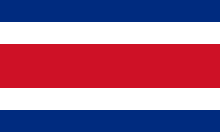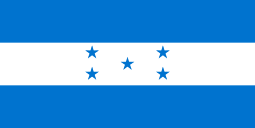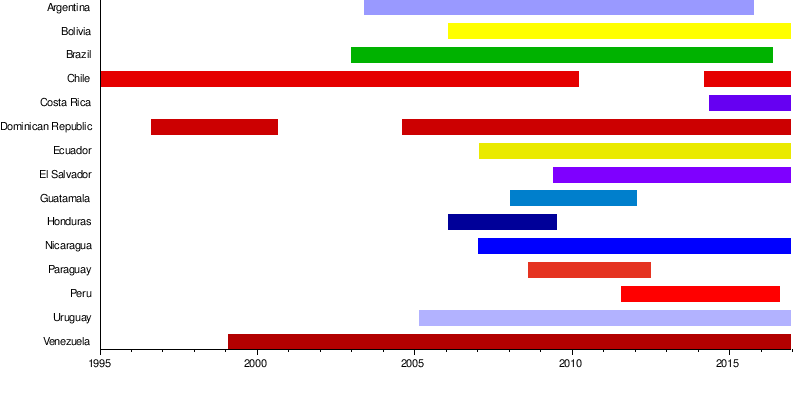Pink tide

The term "pink tide" (Spanish: marea rosa, Portuguese: onda rosa) or "turn to the Left" (Sp.: vuelta hacia la izquierda, Pt.: Guinada à Esquerda) are phrases used in contemporary 21st century political analysis in the media and elsewhere to describe the perception of a turn towards left wing governments in Latin-American democracies straying away from the then more frequent neo-liberal economic model. This occurred primarily between 1998 and 2009,[1][2] entering in relative stagnation and decline afterwards.
Analysts have pointed out additional anti-American,[1] populist,[3][4][5][6] and authoritarian-leaning traits in those governments.[3][7] The Latin American countries viewed as part of this ideological trend have been referred to as "Pink Tide nations".[8] The term post-neoliberalism has been used as a term to refer to the Pink Tide.
Background
In the 1990s, following the end of the Cold War, Latin-American countries turned towards neo-liberal economic policies and underwent a process of privatization of public companies, cuts in public spending, foreign investment and espousing of free market policies.[9] These neo-liberal economic policies promoted by the IMF and the World Bank were dubbed as the "Washington consensus".[9] According to the BBC, a "common element of the 'pink tide' is a clean break with what was known at the outset of the 1990s as the 'Washington consensus', the mixture of open markets and privatisation pushed by the United States".[5] The Neo-liberal experiment collapsed in several countries by the end of the decade, leaving the different economies with features such as high level of unemployement, corruption, inflation and increasing inequality.[9] With the difficulties facing emerging markets across the world at the time, Latin Americans turned away from the liberal economics and used the promoted democracy to elect leftist leaders, with nearly half of a dozen elected governments turning to authoritarianism.[2] With China becoming a more industrialized nation at the same time and requiring resources for its growing economy, it took advantage of the strained relations with the United States and partnered with the leftist governments.[2]
According to Cristina Fernández de Kirchner, a pink tide president herself, Hugo Chávez of Venezuela (inaugurated 1999), Lula da Silva of Brazil (inaugurated 2003) and Evo Morales of Bolivia (inaugurated 2006) were "the three musketeers" of the left in South America.[10] By 2005, the BBC reported that out of 350 million people in South America, three out of four of them lived in countries ruled by "left-leaning presidents" elected during the preceding six years.[5]
Use of the term
The term "pink tide" had become prominent in contemporary discussion of Latin American politics in the early 21st century. Origins of the term may be linked to a statement by Larry Rohter, a New York Times reporter in Montevideo who characterized the election of Tabaré Vázquez as leader of Uruguay as "not so much a red tide…as a pink one."[6] The term seems to be a play on words based on "red tide" (a biological phenomenon rather than a political one) with "red" – a color long associated with communism – being replaced with the lighter tone of "pink" to indicate the more moderate communist and socialist ideas that gained strength.[11]
Despite the presence of a number of Latin American governments which professed to embracing a leftist ideology, it is difficult to categorize Latin American states "according to dominant political tendencies, like a red-blue post-electoral map of the United States."[11] According to the Institute for Policy Studies, a leftist think-tank based in Washington, D.C.:
| “ | …a deeper analysis of elections in Ecuador, Venezuela, Nicaragua, and Mexico indicates that the "pink tide" interpretation—that a diluted trend leftward is sweeping the continent—may be insufficient to understand the complexity of what's really taking place in each country and the region as a whole.[11] | ” |
While this political shift was difficult to quantify, its effects were widely noticed. According to the Institute for Policy Studies, 2006 meetings of the South American Summit of Nations and the Social Forum for the Integration of Peoples demonstrated that certain discussions that "used to take place on the margins of the dominant discourse of neoliberalism, now moved to the center of public debate."[11]
Reaction
In 2006, The Arizona Republic stated:[12]
| “ | Something's happening in Latin America. A couple of decades ago, the region, long considered part of the United States' backyard, was basking in a resurgence of democracy, sending military despots back to their barracks. Now, however, some warn that U.S. influence and free-market economics are falling into wide disfavor. ... Some officials fear a wave of nationalist, leftist leaders washing across Latin America in a "pink tide." | ” |
According to a 2007 report from the Inter Press Service news agency:[13]
| “ | …elections results in Latin America appear to have confirmed a left-wing populist and anti-U.S. trend – the so-called “pink tide” – which, along with the recent disclosures regarding ties between right-wing paramilitaries and the government of Colombian President Álvaro Uribe, poses serious threats to Washington's multi-billion-dollar anti-drug effort in the Andes. | ” |
Decline
To a certain extent, I think the left has exhausted itself in many parts of Latin America ... The citizenry has begun to see the excesses we saw in Argentina, the stagnation we are seeing in Brazil, or, in the case of Venezuela, the absolute failure of an incumbent party.
David Shirk, University of San Diego [10]
Hugo Chávez, who had "dreams of continental domination", was seen as a threat to his own people according to Michael Reid in Foreign Affairs, with his influence reaching a peak in 2007.[2] The interest in Chávez waned after his dependence of oil revenue led Venezuela into an economic crisis and as he grew increasingly authoritarian.[2] The death of Hugo Chávez in 2013 left the most radical wing without a clear leader, as Nicolás Maduro did not have the same international influence of his predecessor. National policies among the left are divided between the styles of Chávez and Lula da Silva, as Lula focused on the poor people but also in private enterprises and global capital.[14] In 2015, the shift away from the left became more pronounced in Latin America. With The Economist saying the Pink Tide had ebbed[15] and Vice News stating that 2015 was "The Year the 'Pink Tide' Turned".[10] By 2016, the decline of the pink tide saw an emergence of a "new right" in Latin America.[16]
According to The New York Times, "Latin America’s leftist ramparts appear to be crumbling because of widespread corruption, a slowdown in China’s economy and poor economic choices", with the newspaper elaborating that leftist leaders did not diversify economies, had unsustainable welfare policies and disregarded democratic behaviors.[17]
Corruption and protests
Leftist governments like their right-leaning preceding governments became ensnarled in corruption as well.[18] From 2014 into 2016, multiple protests occurred against leftist governments. In Venezuela, the 2014–16 Venezuelan protests occurred due to socioeconomic problems and corruption. The 2014–16 Nicaraguan protests occurred due to actions performed by President Ortega and the construction of the Nicaragua Canal. Millions of Brazilians participated in the 2015–16 protests over corruption surrounding President Rousseff and Lula da Silva, while demanding Rousseff's impeachment. The 2015 Ecuadorian protests occurred when Ecuadorians began to disapprove of actions made by President Correa.
Economy
Economic hardships occurred in countries such as Brazil and Venezuela as oil and commodity prices declined.[19] With leftist governments spending largely on their populist social policies, they failed to save money for a potential drop in commodity prices and saw their economies falter as a result.[18]
According to President of Inter-American Dialogue, Michael Shifter regarding the economic situation:
| “ | You’re seeing this wave or tide or whatever you want to call it has run its course. They don’t have the economic sustenance to continue ... This kind of fiery leftist rhetoric was a function of the economic situation, and that has changed dramatically for many of these countries".[19] | ” |
The United States–Cuban Thaw occurred with Cuba reapproaching the United States when Cuba's main international partner, Venezuela, began experiencing economic hardships.[20][21]
Public support and elections
If the start of the 21st century represented a new beginning for the Latin left ... the region may now be seeing the birth of a new right.
Leftist leaders saw a sharp decline of support with Brazil's Dilma Rousseff approval dropping to 9% as of July 2015,[22] Peru's Ollanta Humala at 14% as of October 2015,[23] Chile's Michelle Bachelet near 24% as of September 2015[24] and Nicolás Maduro at 24.3% in July 2015.[25]
Elections also signified the decline of the Pink Tide. Due to lack of public support, Ecuador's Rafael Correa decided not to pursue reelection.[16] The election of the center-right Mauricio Macri in November 2015 as President of Argentina brought a right-wing government to power, although the populist movements of Peronism and Kirchnerismo (tied to its leader Fernández de Kirchner's popularity)[26] remain strong generally.[10] In Venezuela, the opposition electoral coalition Democratic Unity Roundtable won a 2/3 supermajority of the Venezuelan National Assembly the 2015 Venezuelan parliamentary election a month after the election of Macri in December 2015.[10] In a referendum held on 21 February 2016 voters rejected, by a narrow margin, a constitutional amendment to allow Bolivian President Evo Morales to run for a fourth term as president.[27] Pedro Pablo Kuczynski won the 2016 Peruvian elections, and becomes yet another country that departs from a centre-left government.[28] On 31 August 2016, Brazil's president, Dilma Rousseff, was impeached and removed from office, with her right-wing vice president Michel Temer taking her place in office.[16]
Presidents elected
Below are Left-wing and Centre-left presidents elected in Latin America since 1995
Note: Centre-left presidents are marked with *
 Argentina: Néstor Kirchner* (2003–2007), Cristina Fernández de Kirchner* (2007–2015)
Argentina: Néstor Kirchner* (2003–2007), Cristina Fernández de Kirchner* (2007–2015) Bolivia: Evo Morales (2006–present)
Bolivia: Evo Morales (2006–present) Brazil: Luiz Inácio Lula da Silva* (2003–2011), Dilma Rousseff* (2011–2016)
Brazil: Luiz Inácio Lula da Silva* (2003–2011), Dilma Rousseff* (2011–2016) Chile: Eduardo Frei Ruiz-Tagle* (1994–2000), Ricardo Lagos* (2000–2006), Michelle Bachelet* (2006–2010, 2014–present)
Chile: Eduardo Frei Ruiz-Tagle* (1994–2000), Ricardo Lagos* (2000–2006), Michelle Bachelet* (2006–2010, 2014–present) Costa Rica: Luis Guillermo Solís* (2014–present)
Costa Rica: Luis Guillermo Solís* (2014–present) Dominican Republic: Leonel Fernández* (1996–2000, 2004–2012), Danilo Medina* (2012–present) [29]
Dominican Republic: Leonel Fernández* (1996–2000, 2004–2012), Danilo Medina* (2012–present) [29] Ecuador: Rafael Correa (2007–present)
Ecuador: Rafael Correa (2007–present) El Salvador: Mauricio Funes* (2009–2014), Salvador Sánchez Cerén* (2014–present)
El Salvador: Mauricio Funes* (2009–2014), Salvador Sánchez Cerén* (2014–present) Guatemala: Álvaro Colom* (2008–2012)
Guatemala: Álvaro Colom* (2008–2012) Honduras: Manuel Zelaya* (2006–2009)[30]
Honduras: Manuel Zelaya* (2006–2009)[30] Nicaragua: Daniel Ortega (1979–1990, 2007–present)
Nicaragua: Daniel Ortega (1979–1990, 2007–present) Paraguay: Fernando Lugo (2008–2012)
Paraguay: Fernando Lugo (2008–2012) Peru: Ollanta Humala* (2011–2016)
Peru: Ollanta Humala* (2011–2016) Uruguay: Tabaré Vázquez* (2005–2010, 2015–present), José Mujica* (2010–2015)
Uruguay: Tabaré Vázquez* (2005–2010, 2015–present), José Mujica* (2010–2015) Venezuela: Hugo Chávez (1999–2013), Nicolás Maduro (2013–present)
Venezuela: Hugo Chávez (1999–2013), Nicolás Maduro (2013–present)
Timeline

See also
- Bolivarianism
- Bolivarian Alliance for the Americas
- Foro de São Paulo
- History of Latin America
- Kirchnerism
- Latin American drug legalization
- Latin American integration
- Pan-Americanism
- Socialism of the 21st century
References
- 1 2 da Cruz, Jose de Arimateia (2015). "STRATEGIC INSIGHTS: FROM IDEOLOGY TO GEOPOLITICS: RUSSIAN INTERESTS IN LATIN AMERICA". Current Politics and Economics of Russia, Eastern and Central Europe. Nova Science Publishers. 30 (1/2): 175–185.
- 1 2 3 4 5 Reid, Michael (Sep–Oct 2015). "Obama and Latin America: A Promising Day in the Neighborhood". Foreign Affairs. 94 (5): 45–53.
- 1 2 Isbester, Katherine (2011). The Paradox of Democracy in Latin America: Ten Country Studies of Division and Resilience. Toronto: University of Toronto Press. p. xiii. ISBN 978-1442601802.
- ↑ Boston Globe: The many stripes of anti-Americanism
- 1 2 3 BBC News: South America's leftward sweep
- 1 2 Pittsburg Tribune-Herald: Latin America's 'pragmatic' pink tide
- ↑ "Once Saudi Venezuela, now a 'pink tide' casualty". The Chicago Tribune. 30 June 2016. Retrieved 30 June 2016.
- ↑ SustainabiliTank: Guatemala
- 1 2 3 Rodriguez, Robert G. (2014). "Re-Assessing the Rise of the Latin American Left" (PDF). The Midsouth Political Science Review. Arkansas Political Science Association. 15 (1): 59. ISSN 2330-6882.
- 1 2 3 4 5 Noel, Andrea (29 December 2015). "The Year the 'Pink Tide' Turned: Latin America in 2015 | VICE News". VICE News. Retrieved 30 December 2015.
- 1 2 3 4 "Archived copy". Archived from the original on September 10, 2009. Retrieved March 24, 2016. Institute for Policy Studies: Latin America's Pink Tide?
- ↑ "The Issue: A Changing Latin America: Fears of 'Pink Tide'". The Arizona Republic. 12 June 2006.
- ↑ Inter Press Service: Challenges 2006–2007: A Bad Year for Empire
- ↑ Latin America's political right in decline as leftist governments move to middle
- ↑ "The ebbing of the pink tide". The Economist.
- 1 2 3 4 de Oliveira Neto, Claire; Howat Berger, Joshua (1 September 2016). "Latin America's 'pink tide' ebbs to new low in Brazil". Agence France-Presse. Retrieved 3 September 2016.
- ↑ "The Left on the Run in Latin America". The New York Times. 23 May 2016. Retrieved 5 September 2016.
- 1 2 G. Castañeda, Jorge (22 March 2016). "The Death of the Latin American Left". The New York Times. Retrieved 23 March 2016.
- 1 2 Partlow, Joshua; Caselli, Irene (23 November 2015). "Does Argentina's pro-business vote mean the Latin American left is dead?". The Washington Post. Retrieved 30 December 2015.
- ↑ "Why the United States and Cuba are cosying up". The Economist. 29 May 2015. Retrieved 14 November 2015.
- ↑ Usborne, David (4 December 2015). "Venezuela's ruling socialists face defeat at polls". The Independent. Retrieved 30 December 2015.
- ↑ "Avaliação positiva do governo Dilma cai para 9%". Carta Capital. 1 July 2015. Retrieved 17 July 2015.
- ↑ Diario La República. "Aprobación de Ollanta Humala en octubre de 2015".
- ↑ Rosario Álvarez, Adimark: Bachelet obtiene 24% de aprobación registrando la peor cifra en la historia de la encuesta Politica, 02 de septiembre del 2015
- ↑ Ulmer, Alexandra (13 August 2015). "Popularity of Venezuela's Maduro inches down to 24.3 percent". Reuters. Retrieved 30 December 2015.
- ↑ Argentina's Ex-President Wants Everyone to Know She's Not Scared of Corruption Probes – VICE News, April 14, 2016
- ↑ "Bolivian voters reject fourth term for Morales – BBC News". BBC News. Retrieved 2016-02-25.
- ↑ Oliver Stuenkel (June 8, 2016). "Peru: Kuczynski victory is part of a broader political shift in the region". Post Western World. Retrieved June 12, 2016.
- ↑ The Dominican Liberation Party in which both Dominican presidents belong to has a centrist position.
- ↑ During his presidency Zelaya was a member of the Liberal Party of Honduras.